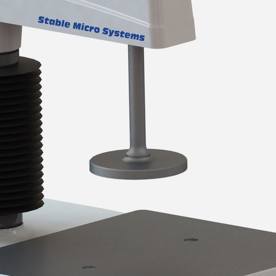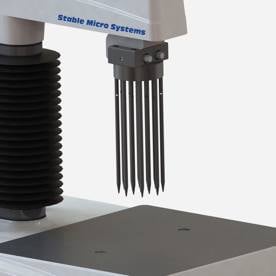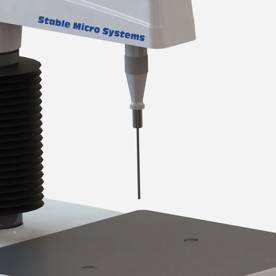How to measure hardness

Hardness: definition and importance
Hardness measures a material's resistance to deformation, typically through indentation by a harder object. In materials science, hardness tests are crucial for determining how a material behaves under load, making them vital for quality control, research, and product development across industries such as metals, pharmaceuticals, cosmetics, and food. Hardness is not a fundamental property – it can change with factors like heat. It is also influenced by other properties such as stiffness, strength, and ductility, particularly in metals. Measuring hardness helps determine whether a material is suitable for specific applications or products.
Types of hardness in food texture analysis
Indentation Hardness: Indentation hardness measures the resistance of a material to being indented by a probe. In food products, for example, the hardness of a fruit, cheese, or candy can be measured by pressing a probe into the surface and recording the force required to create an indentation.
Penetration Hardness: Penetration hardness refers to how much force is needed for a probe to penetrate a material. This type of hardness is especially important in products like bread, cakes, or gels where the ease of cutting or biting into the product is essential for consumer satisfaction.
Breaking Hardness: Breaking hardness measures the force required to cause a material to break. This is important in products like crackers, cookies, and hard candies, where a satisfying "crack" or snap is desired.
Further example applications of hardness testing
Hardness measurements using a Texture Analyser are applied across many industries to assess material performance. Below are key applications:
- Texture analysis of food products: Measuring the hardness of fruits, vegetables, and baked goods to evaluate ripeness or freshness by applying controlled load to assess deformation. Hard cheeses like Parmesan exhibit high hardness, requiring more force to cut or slice. Softer cheeses like Brie will show lower hardness, with the probe traveling further before encountering significant resistance. Hard candies, such as lollipops or boiled sweets, have high hardness, while softer candies like marshmallows or gummy candies show lower hardness in texture analysis.
- Pharmaceutical tablets hardness testing: Evaluating the hardness of tablets to ensure they meet quality standards of mechanical stability during packaging and transport by measuring the force required to break or compress them. Tablets that are too hard may not dissolve easily, while tablets that are too soft may crumble during transport.
- Material hardness testing: Measuring the hardness of solid materials like metals, plastics, and ceramics to determine wear resistance and durability by indenting them and analysing the force-depth curve. Hardness is an important factor in determining how rigid or flexible a plastic or rubber material is. Harder plastics are used for durable applications, while softer rubbers are used for flexibility and cushioning.
- Cosmetic product testing: Hardness is critical in products like lip balms and soaps, where a certain firmness is required for handling and influences application and skin feel. Softer balms or soaps may deform too easily, while harder versions maintain their shape during use.
- Pharmaceutical gel capsule hardness testing: Testing the hardness of gel capsules by compressing them to determine their resistance to deformation and strength helps ensure that they maintain their shape and don’t break or leak during storage.
- Tissue hardness testing: Evaluating the mechanical properties of tissue samples in medical research by measuring the hardness of biological tissues.
- Paper and packaging material testing: Measuring the hardness and strength of paper and packaging materials by recording the penetration resistance of a probe.
- Textile material testing: Assessing the hardness and flexibility of textiles by measuring the force required to deform a fabric sample.
In these examples, a Texture Analyser applies controlled forces/distances to assess material hardness, providing essential data for quality control, product development, and research across various industries.
Typical probe/attachment used for measurement
When measuring hardness, a force is usually applied whereby either the penetration depth or the size of the indentation caused by the indenter is measured. Alternatively, using a Texture Analyser the force to go to a set distance in the material would also indicate and be a suitable way to assess hardness. Brinell, Vickers and Shore hardness are all methods that measure material hardness and can be easily determined using a Texture Analyser.
Whilst indentation is the traditional way of measuring hardness, the term hardness can be so broadly used that there are other options of empirically or imitatively measured the property of hardness according to a customer’s perception of the property, such as bending, compression or tension. In certain cases, the product or sample may have a limitation of presenting to the Texture Analyser for testing according to a standard method. A non-standard compromising solution can usually be found to optimise the testing of the required product property.
How to interpret the Texture Analyser graph
 Typical curve indicating key analysis points of a hardness test
Typical curve indicating key analysis points of a hardness test
When measuring hardness, the force vs distance/time graph typically shows how much force is needed to achieve a certain amount of deformation, allowing for the quantification of hardness. From the graph you can observe/obtain the following:
- Hardness
- Work of penetration
- Work of compression
- Ductility
- Yield strength
- Stiffness
- Strength
- Strain
A full explanation of this curve and its analysis can be accessed within Exponent Connect software. Existing Exponent users can upgrade to Exponent Connect specification.
Below is a video example of how we can help you understand curve analysis for an example property.
Key factors affecting hardness measurement
- Surface preparation: Proper surface preparation, including cleaning and polishing, is crucial for accurate hardness measurements as surface irregularities can affect the indentation process.
- Testing speed: The rate at which the probe is applied can influence the hardness measurement, especially for materials that exhibit time-dependent/viscoelastic deformation.
- Applied distance/load: The applied distance/load during hardness testing must be appropriate for the material being tested.
- Probe geometry: The geometry and material of the probe significantly influence the hardness measurement and must be selected based on the test method and material properties.
- Sample thickness: The thickness of the test sample should be sufficient to prevent the indentation from being affected by the underlying support, typically at least 10 times the indentation depth.
- Temperature: The temperature of both the sample and the testing environment can affect material properties and should be controlled or accounted for during hardness testing. Materials are generally harder at lower temperatures and soften as they warm up. For instance, chocolate becomes softer and less resistant to compression at room temperature than when it's cold.
- Material homogeneity: The uniformity of the material's structure and composition can affect hardness measurements, particularly for materials with large grains or non-uniform properties.
Optimising hardness measurement and analysis: The Stable Micro Systems advantage
The Stable Micro Systems Texture Analyser excels in optimising hardness measurements through its comprehensive approach and advanced features. It offers high-precision measurements with force resolution of 0.1g and distance resolution of 0.001mm, ensuring accurate quantification of hardness properties across a wide range of materials.
The Texture Analyser’s versatility allows for testing various products, from foods to pharmaceuticals, while its Exponent Connect software captures detailed force-distance-time profiles for in-depth analysis at up to 2000 points per second. With a vast range of customisable probes and fixtures, and models capable of measuring forces up to 750kg, it adapts to diverse sample requirements and hardness levels.
Backed by Stable Micro Systems' expertise in method development and data interpretation, this makes it the ideal choice for industries seeking to refine product formulations and maintain quality standards in hardness testing.
A choice of industry standard hardness testing probes.
Comprehensive analysis of graph features offering detailed force-time-distance profiles at up to 2000 points per second.
Ability to additionally capture synchronised video for better understanding of product behaviour.
Adjust settings to match specific product requirements or use industry standard protocols.
If you need help with your gel property measurements, we offer unrivalled support.
Be guided through the steps to successful testing and analysis of gel strength.








